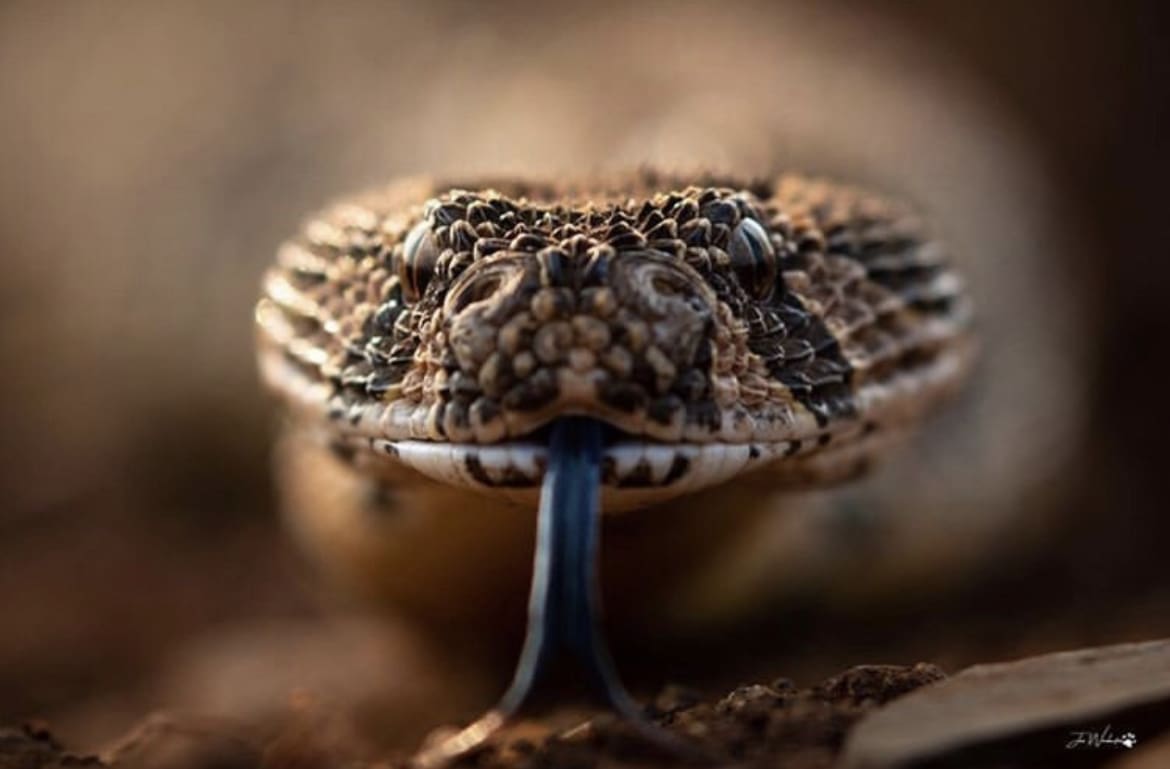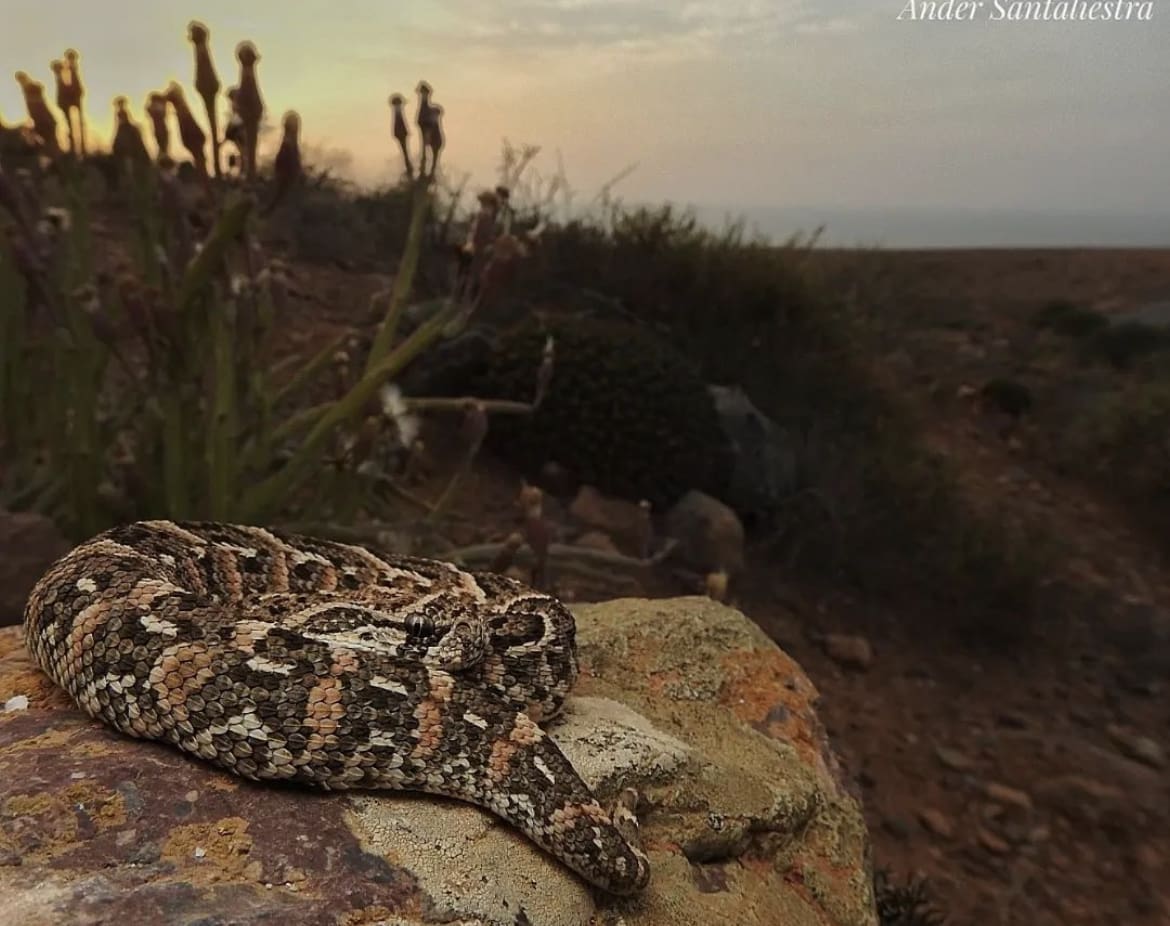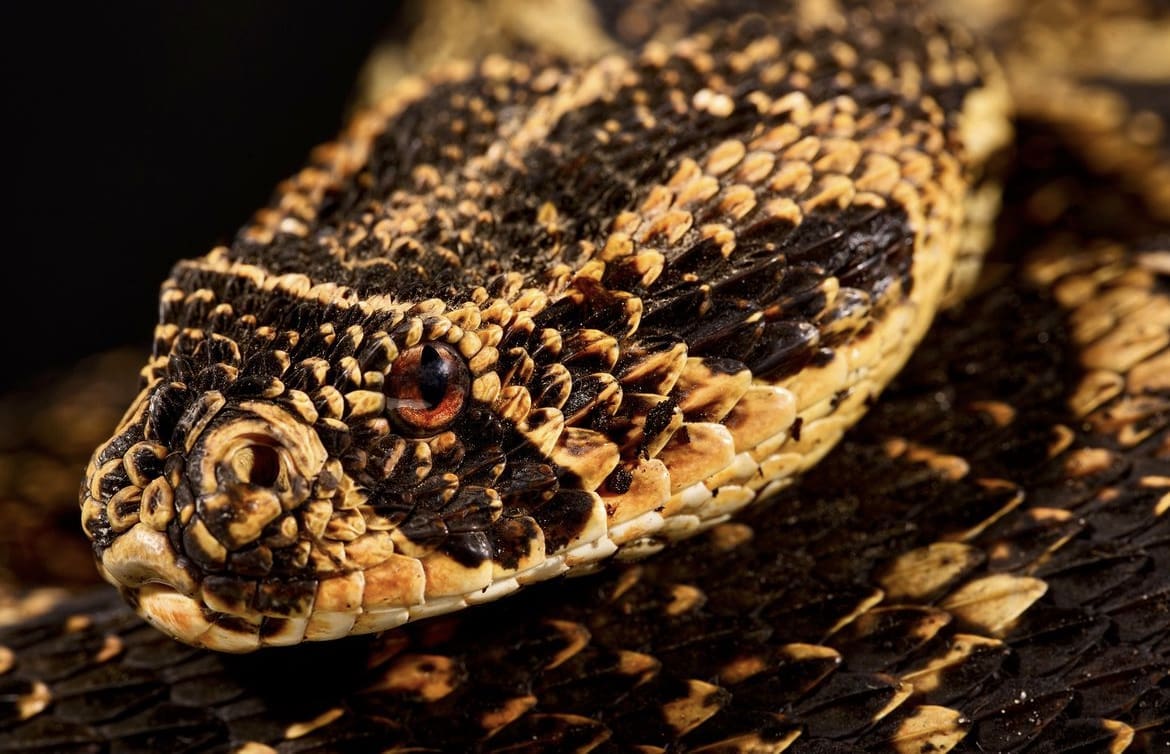The Puff Adder isn’t just another character in the vast storybook of African wildlife; it’s a creature that demands respect, curiosity, and a bit of awe. S
o, let’s dive deep and get the lowdown on one of nature’s most misunderstood beauties, shall we?
What is the Puff Adder?
The Puff Adder (Bitis arietans) is the equivalent of that one friend who’s chill until you accidentally step on their sneakers. Known for its distinctive “huff and puff” defense mechanism, this snake is a staple in African folklore and ecosystems. Belonging to the viper family, it’s got a reputation that precedes it – thanks to its potent venom and widespread presence across the African continent and parts of the Middle East.
But here’s the twist: the Puff Adder is a complex creature, not just a venomous villain in tales of the wild. Its role is pivotal in controlling pest populations, making it a crucial player in its habitat. With a lineage dating back to who knows when (science is still figuring that out), the Puff Adder has coexisted with humans for centuries, sparking a mix of fascination and fear.
What do Puff Adders Look Like?
Sporting a thick, heavy-bodied frame, these guys are the fashionistas of the snake world. Their skin is a kaleidoscope of earthy tones – think browns, yellows, grays, and everything in between. These colors aren’t just for show; they’re a masterclass in camouflage, allowing them to blend seamlessly into their surroundings.
Their heads are somewhat triangular, with a snout that looks like it’s always up to something sneaky. And those eyes – oh, those eyes! With vertical pupils that could give any cat a run for its money, the Puff Adder’s gaze is mesmerizing and a tad intimidating.

How Big are Puff Adders?
Now, size does matter in the wild, and the Puff Adder knows it. These snakes aren’t about to win any “longest snake” contests, but what they lack in length, they make up for in girth. Adults typically stretch out to about 1 to 1.5 meters (3 to 5 feet) long, making them a substantial presence on the ground.
But here’s the kicker: despite their chunky appearance, they’re surprisingly good at hiding. Their size, combined with their coloration, makes them adept at lying in wait for unsuspecting prey or chilling out without drawing too much attention from predators or overly curious humans.
Puff Adder Skin
Ever wondered what it would be like to wear a suit of armor that’s also a masterpiece of natural art? Well, the Puff Adder pretty much does. Their skin isn’t just their outfit; it’s their shield, their camouflage, and their statement piece all rolled into one. The scales of a Puff Adder are keeled, meaning each scale has a ridge down its center, adding a rough texture that’s all about function.
This texture breaks up the outline of the snake, making it harder for both prey and predators to spot. Plus, it’s perfect for a lifestyle spent lounging on the African savannah or tucked away in rocky outcrops. Whether they’re soaking up some rays or waiting patiently for dinner to stroll by, their skin keeps them hidden in plain sight.

Puff Adder Horns
Hold up, horns? Well, not exactly in the way you might think. When we talk about “horns” in the context of Puff Adders, we’re diving into the realm of myth a bit. Puff Adders don’t have horns per se, but their appearance often gives off a somewhat horned vibe, thanks to the distinctive shape of their heads and the position of their scales.
In some snake species, like certain types of vipers, you’ll find actual horns protruding from their snouts or above their eyes. But our friend the Puff Adder keeps things a bit more low-key. The shape and setting of their scales around the head can give an illusion of horns, which adds to their intimidating demeanor. It’s all about the aesthetics for these creatures, combining form and function to navigate their world.
Puff Adder Colouration
Let’s talk about the Puff Adder’s paint job. If you’re into the natural look, these guys are your aesthetic goals. Their colouration is a masterclass in the art of blending in. With a base that can range from yellows to browns and even a dusky grey, overlaid with darker bands or chevron-shaped markings, they’re the epitome of earth-toned beauty.
This isn’t just about looking good, though. The Puff Adder’s colouration plays a crucial role in their survival strategy. Those bands and markings mimic the shadows and lights of their natural habitat, making them practically invisible to both their prey and predators. It’s like their own version of an invisibility cloak. Whether nestled amongst leaves or lying on a sun-dappled rock, they can stay undetected until they’re ready to make their move.
What do Puff Adders Eat?
Alright, let’s get into the gourmet world of the Puff Adder. Imagine being so chill that dinner literally walks into your mouth. That’s the Puff Adder for you. These guys are ambush predators, meaning they’ve mastered the art of the wait. Patience is their game, lying in camouflage for the perfect moment to strike.
Their menu? It’s pretty diverse. From small mammals like rodents to birds, lizards, and occasionally, some unlucky frogs, the Puff Adder isn’t too picky. Their technique is simple yet effective: a quick, venomous strike, then they wait for the venom to do its magic before swallowing their meal whole. It’s not for the faint-hearted, but hey, a snake’s gotta eat.

Puff Adder Social Structure
If you’re picturing Puff Adders throwing wild parties, you might be a tad disappointed. These snakes are solitary creatures, preferring their own company over the hustle and bustle of social snake life. The majority of their interactions with fellow Puff Adders are during the mating season, and even then, it’s a brief affair.
Their social structure, or lack thereof, is all about the solo life. They have their own territories, which they patrol and hunt within, but there’s not much in terms of community living. Think of them as the introverts of the snake world, enjoying the peace and quiet of their own space, only coming together for the sake of continuation of the species.
How do Puff Adders Reproduce?
Speaking of continuation, let’s talk about Puff Adder romance. It’s not all candlelit dinners and roses; reproduction in the Puff Adder world is a fascinating, albeit brief, affair. They’re ovoviviparous, which is a fancy way of saying they give birth to live young. No egg-laying for these serpents.
Mating season sees males following the scent trails of females, and when they find a suitable partner, a bit of a dance ensues. This can sometimes involve male-to-male combat if there’s competition. But it’s all for a good cause: ensuring the strongest genes get passed on. After mating, females go on their merry way, eventually giving birth to a litter of mini puff adders ready to take on the world.

How Long do Puff Adders Live?
Puff Adders, those resilient survivors of the snake world, have a surprisingly decent innings when it comes to lifespan. In the wild, they can live up to 10 or even 15 years, depending on the generosity of Mother Nature and their luck in avoiding predators, disease, and human encounters. In captivity, where threats are minimized, these snakes can push their life expectancy even further, sometimes reaching up to 20 years with proper care.
Their longevity is a testament to their adaptability and the efficiency of their lifestyle – slow, steady, and strategic, making every move count. It’s a marathon, not a sprint, for these serpents, navigating the challenges of the wild with a calculated patience.
Are Puff Adders Aggressive?
Now, onto the million-dollar question: Are Puff Adders aggressive? The short answer is no, not inherently. The long answer? They’re misunderstood. Puff Adders don’t go looking for trouble. They’d much rather avoid confrontation and go about their business. However, when threatened, they can and will defend themselves with that infamous hiss and, if necessary, a venomous bite.
Their reputation for aggression largely stems from their potent venom and the fact that they’re often encountered by humans, leading to unfortunate incidents. However, it’s their defensive nature, rather than an aggressive disposition, that characterizes their interactions with the world at large.

Are Puff Adders Territorial?
When it comes to real estate, Puff Adders are somewhat laissez-faire. They’re not territorial in the aggressive, defend-at-all-costs way some animals are. However, they do have preferred hunting and living areas that they stick to, areas rich in food and suitable for their camouflage tactics.
During mating season, males might roam more widely in search of females, but even then, there’s not a strong sense of territory defense. It’s more about finding a mate than about guarding a specific patch of land. The Puff Adder’s approach to territory is practical and flexible, adapting to the opportunities and challenges of their environment.
How Fast are Puff Adders?
Speed and agility may not be the first attributes that come to mind when you think of a Puff Adder, given their somewhat hefty appearance and laid-back hunting style. However, when it comes to striking, they’re the Olympians of the snake world. A Puff Adder can launch itself at an astonishing speed when striking prey or in defense, making it a formidable predator and a creature you’d rather not surprise.
But don’t get it twisted; they’re not exactly chasing down their dinners or sprinting away from threats. Their speed is all in the strike – a burst of action in an otherwise tranquil existence.
Can Puff Adders Kill People?
The Puff Adder’s venom is potent, no doubt about it, and they are responsible for more snakebite fatalities in Africa than any other snake. This is partly due to their widespread presence and the fact that they tend to freeze when approached, leading to unfortunate encounters with humans. However, it’s important to remember that these snakes are not out to get us. Most bites occur because the snake is stepped on or provoked.
With prompt and proper medical treatment, the prognosis after a Puff Adder bite is generally good. It’s a reminder of the importance of being aware of our surroundings and respecting the wildlife we share our spaces with. The Puff Adder doesn’t seek conflict; it’s all about self-defense.

Where do Puff Adders Live?
Talk about a snake that’s adaptable! The Puff Adder has one of the widest distributions of any African snake, making itself at home in a variety of habitats. From the savannahs and grasslands to forests and even semi-desert regions, these snakes are not picky tenants. They’re found throughout sub-Saharan Africa and parts of the Arabian Peninsula, thriving in both dry and moist environments.
What makes these locations ideal? A combination of good hiding spots, ample sunshine for basking, and a steady supply of food. Whether it’s curling up under a rock, nestling in fallen leaves, or lounging in a sunny patch, the Puff Adder knows how to pick a prime spot to call home.
How Many Puff Adders are There in the Wild?
Quantifying the exact number of Puff Adders in the wild is akin to solving a complex puzzle with half the pieces missing. Due to their secretive nature and vast distribution, getting accurate population figures is challenging. However, it’s widely accepted that they’re among the most common venomous snakes in many parts of Africa.
Despite their apparent abundance, local populations can face pressures from habitat destruction and human-wildlife conflict, leading to fluctuations and potential declines in certain areas. Conservationists keep a keen eye on these trends, aiming to balance human coexistence with these remarkable reptiles.

Are Puff Adders Endangered?
Currently, the Puff Adder is not listed as endangered on a global scale. Thanks to their adaptability and wide distribution, they’ve managed to maintain relatively stable populations in the face of changing environments. However, “not endangered” doesn’t mean “no worries.”
Local populations can suffer from specific threats, including targeted killings due to fear or misunderstanding, habitat loss from agricultural expansion, and road mortality. Conservation efforts are essential not just for the Puff Adders but for the myriad other species that share their ecosystems, highlighting the interconnectedness of our natural world.
Threats to Puff Adders in the Wild
The life of a Puff Adder isn’t without its challenges. Beyond the natural threats from predators and competition for resources, human activity poses significant risks. Habitat destruction fragments their living spaces, reducing access to food and safe breeding grounds. Moreover, Puff Adders often fall victim to roadkill due to their tendency to bask on warm roads, especially at night.
Another notable threat is the deliberate killing by humans. Misunderstandings and fear lead to many Puff Adders being killed on sight, a reaction fueled by their reputation rather than an understanding of their behavior and ecological role. Education and awareness are key in shifting perceptions and fostering coexistence with these vital components of biodiversity.
Where to See Puff Adders in the Wild
For the nature enthusiasts and snake aficionados among us, observing a Puff Adder in its natural habitat can be a thrilling experience. These snakes are widespread across sub-Saharan Africa, with their presence also noted in parts of the Arabian Peninsula. Wildlife reserves, national parks, and protected areas offer the best chances to see Puff Adders while minimizing disturbances to their natural behaviors.
Countries like South Africa, Botswana, Kenya, and Tanzania boast robust populations within their conservation areas. Guided tours and safari walks with experienced guides enhance the likelihood of encounters while ensuring safety for both the observer and the observed.

Tips for Spotting Puff Adders in the Wild
Spotting a Puff Adder requires a blend of patience, knowledge, and respect for nature. Here are some tips to increase your chances of a sighting while keeping safe:
- Stay on Designated Paths: This minimizes the risk of startling a snake and protects their natural environment.
- Look, Don’t Touch: If you’re lucky enough to spot one, admire from a distance. Disturbing a Puff Adder can lead to defensive behavior.
- Dress Appropriately: Wear closed shoes and long trousers when walking in areas known to be inhabited by Puff Adders.
- Learn Their Behavior: Understanding their habits, such as basking in the sun during cooler hours, can help you know where to look.
- Hire a Guide: An experienced local guide can significantly enhance your chances of safely spotting wildlife, including Puff Adders.
Facts about The Puff Adder
- Ambush Predators: They lie in wait for their prey, relying on camouflage and patience.
- Widespread: Found in a variety of habitats across Africa and parts of the Middle East.
- Venomous: Their bite is dangerous due to potent venom, but they prefer to avoid conflict.
- Longevity: Can live up to 10-15 years in the wild and longer in captivity.
- Reproductive: They give birth to live young, with litters ranging from 20 to 40 offspring.
Myths about The Puff Adder
- Aggressive Nature: Contrary to popular belief, Puff Adders are not inherently aggressive and attack only when provoked or threatened.
- Chasing Humans: There’s no truth to the myth that Puff Adders chase people. They’d much rather flee or remain hidden.
- Immunity to Own Venom: Like all snakes, Puff Adders are not immune to their own venom, a common misconception.
